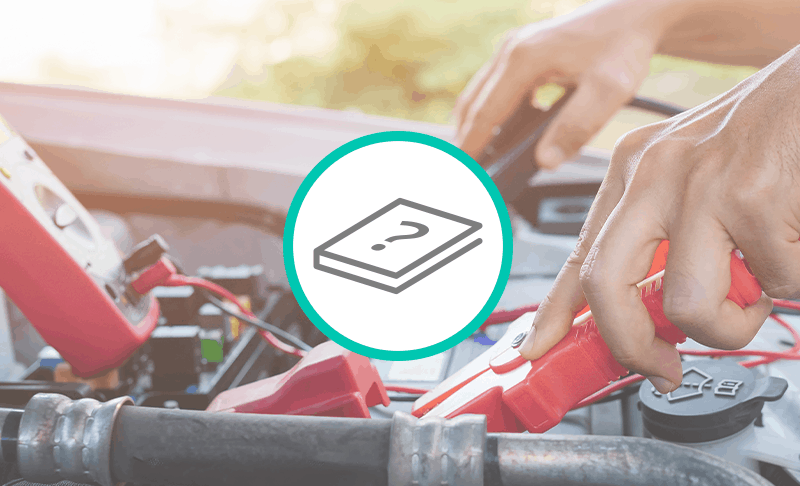
How to Jump Start a Car in 11 Steps
A dead battery is never fun to deal with but it doesn’t have to leave you stranded. Knowing how to jump-start a car and what you’ll need to do it can make a dead battery situation less stressful.
IN THIS POST, WE COVER:
When your car won’t start, it may be a symptom of a bigger problem with the engine. But in many cases, it may be something as simple as a dead battery. If you don’t have time or the means to purchase a new battery right away, a jump-start may be all you need to get going.
Here are a few possible reasons for a dead battery:
- Headlights or interior lights left on.
- Malfunctioning alternator or starter.
- Battery is reaching its typical life expectancy.
- Extreme hot or extreme cold temperatures.
- Malfunctions in the car’s charging system.
- Battery corrosion.
And, here are some important things to know before attempting to jump a battery:
- Remember to take safety precautions so you don’t run the risk of electrical shock.
- Make sure your car is in park or neutral before getting started.
- Extremely cold weather can freeze your battery so use caution when attempting to jump-start your car in those conditions.
- If your car won’t jump-start successfully, you may need to have a mechanic check it to determine what’s wrong.
What’s needed to jump-start a car
There are really only three things that are needed for a jump-start:
- A car with a dead battery.
- A car that has a good battery.
- Jumpter cables to connect them (or a portable jump-starter).
It’s also a good idea to use safety glasses but those aren’t an absolute requirement. You may also want to have gloves on hand or heavy-duty jumper cables in case you have to get your car going in very cold weather.
How to jump-start a car in 11 steps
Giving your battery a jump isn’t as complicated as it might seem but if you’ve never done it before, it’s good to have a step-by-step process you can follow. This checklist walks you through everything you need to know to get your vehicle running again.
- Park the two cars front-end-to-front-end if possible and if not, position them so that they’re close together but not touching. Leaving an 18-inch gap between them is ideal.
- Turn the ignition for both cars off. Put both cars in park or neutral if one or both has a standard transmission. Set the parking brake so there’s no chance of either car rolling away.
- Pop the hoods and find the batteries for each car. Make sure the hoods are secure–you don’t want them falling on you in the middle of trying to jump-start a car.
- Find the positive and negative terminals on each battery. Positive has a (+) next to it while negative is marked by a (-).
- Take the red positive (+) clamp from one end of the jumper cables and connect it to the positive terminal on the dead battery.
- Connect the red positive clamp from the other end of the jumper cables to the positive terminal on the other car’s battery.
- Connect the black negative (-) clamp from that same end of the jumper cable to the negative terminal on the good car’s battery.
- Take the black negative clamp that’s connected to the red positive clamp attached to the dead battery and connect that somewhere else on the car, like part of the frame or a bolt. Don’t attach it to the dead battery, since that can cause sparks.
- If you’ve checked all your connections, the next step is starting the engine on the car with the good battery. Once the car is on, let it run for a few minutes, keeping it connected to the car with the dead battery.
- Try to turn on the engine of the car that had the dead battery. If it doesn’t turn over and start, let it charge for a few more minutes.
- If the car starts, you can disconnect the jumper cables. There’s a specific order they need to be disconnected in:
- Negative cable from the car being jumped first.
- Negative cable from the car with good battery next.
- Positive cable from the car with the good battery.
- Positive cable from the car with the dead (now jumped) battery last.
At this point, your car should have enough charge to continue running. It’s a good idea to drive it for 20 to 30 minutes to give the car’s charging system time to get the battery back up to full charge.
You may want to consider getting your battery checked to see if it needs to be replaced, or having a mechanic check for any other problems, such as a bad alternator, that could be draining the battery.
What if you’re using a jump-start instead of another car?
If you’re using a jump-starter to get your car going, the steps are essentially the same.
You’d need to:
- Make sure the jump-starter and your vehicle are turned off first.
- Connect the positive and negative ends of the jump-starter cables to the positive and negative posts on the jump-starter.
- Connect the other positive end of the cable to the positive terminal on the car battery.
- Connect the negative end to a grounded surface on the vehicle.
- Turn on the jump-starter and let the car charge for a couple of minutes.
- Attempt to start the vehicle. If it starts, you can remove the cables following the same order that you would if you were jump-starting using another vehicle.
Pro tip: After a jump, make sure you recharged the portable starter so it’s ready the next time you need it.
How jump-starting a car works
There’s a little bit of science involved in how jumping a car battery works. Essentially, jump-starting allows you to transfer voltage from one car to another through the jumper cables. Once the dead battery has been recharged, the car’s internal system takes over and the power being fed in by the other vehicle’s battery is no longer needed.
Conducting regular maintenance checks of your vehicle can help you detect any potential battery or mechanical issues. It’s also helpful to be aware of how long your battery is designed to last on average so you can plan in advance for when it’s time to swap it out for a new one.
At Birchwood Credit Solutions, we’re here to help you get the vehicle you need as quickly as possible. We work to serve customers from all varieties of credit backgrounds, including newcomers to Canada, individuals who have been through a bankruptcy or divorce that was damaging to their credit, as well as people who have just establishing credit. Fill out our online application to start the process for purchasing your next vehicle.



